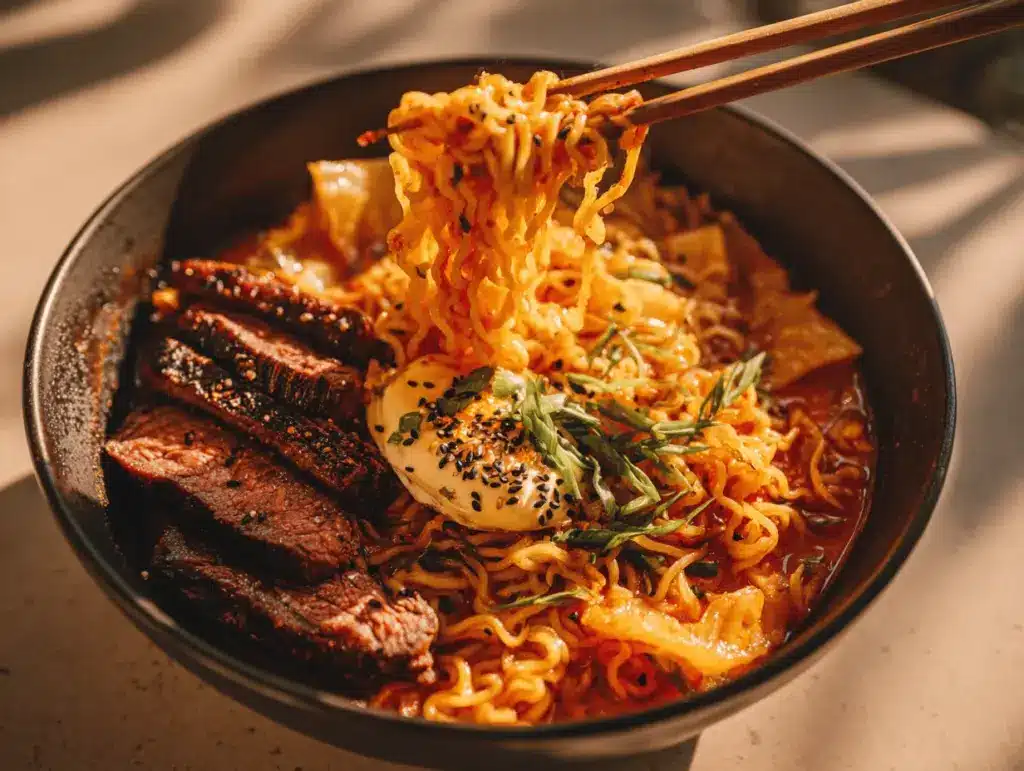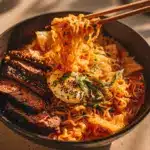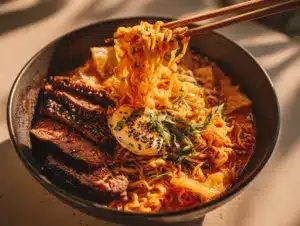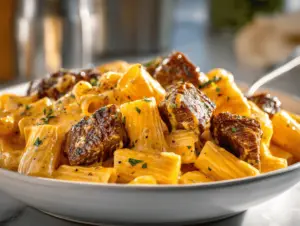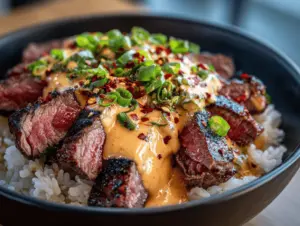The first time I made this spicy Korean ramen with grilled beef and creamy sauce, my entire kitchen filled with the deep, savory aroma of gochujang and sizzling steak. There’s just something about the way spicy noodles mingle with smoky grilled beef—honestly, it’s hard to resist slurping up the whole bowl before it even hits the table. I remember craving a comforting bowl of ramen after a long day, but I wanted something with a little more oomph (and a lot more flavor) than the usual instant stuff. So, I started experimenting with Korean flavors, and let’s just say my taste buds have never looked back.
This spicy Korean ramen recipe isn’t just another noodle bowl—it’s a full-on flavor experience. The chewy noodles, marinated grilled beef, and a creamy sauce that cools the heat just enough make it perfect for spice lovers, comfort food fans, and even picky eaters who just want something a little different. I’ve tested this recipe at least a dozen times, tweaking the marinade, adjusting the spice levels, and fussing over the sauce until it was just right. If you’re looking for a homemade ramen that hits all the marks (spicy, creamy, hearty), you’re in the right place.
Why do I love it so much? For starters, it’s a total crowd-pleaser—my friends have requested it for game nights and casual dinners more times than I can count. It’s also surprisingly easy to pull together, even on busy nights when you just want to unwind with a big, slurpable bowl. Plus, it’s packed with protein, veggies, and that irresistible Korean spice kick. Whether you’re a ramen enthusiast or just in the mood for something cozy and bold, this spicy Korean ramen with grilled beef and creamy sauce is about to become your new favorite.
Why You’ll Love This Spicy Korean Ramen with Grilled Beef & Creamy Sauce
After making this spicy Korean ramen more times than I can count, I’ve learned a thing or two about what makes it special. Here’s why you’ll keep coming back to this recipe—trust me, one bite and you’ll get it:
- Quick & Easy: Ready in about 40 minutes, this is your weeknight hero. No need to fuss with complicated steps or endless simmering—just bold flavor, fast.
- Simple Ingredients: Everything you need is probably already in your pantry or just a quick trip to the grocery store away. No hunting for hard-to-find specialty items.
- Perfect for Cozy Nights: This spicy ramen is ideal for those chilly evenings when you want something warming, filling, and just a little indulgent. It’s also the ultimate comfort food for movie marathons or rainy days.
- Crowd-Pleaser: I’ve served this to friends, family, and even a few self-proclaimed “spice wimps”—everyone raves about the rich, layered flavors. Kids actually like it too (just dial down the heat for them).
- Unbelievably Delicious: The secret is in the balance—the spicy, umami-packed broth, the tender grilled beef, and the creamy, cooling sauce drizzled over the top. It’s an explosion of texture and flavor in every bite.
What sets this spicy Korean ramen recipe apart? For one, I blend a little cream cheese and milk into the sauce, so you get that perfect interplay of spicy and creamy (no bland noodles here). The beef is marinated for max flavor and grilled for that irresistible char, making every mouthful just a little smoky and totally addictive. And let’s not forget the customizable toppings—crisp veggies, soft eggs, fresh herbs—you get to make it your own every time.
More than just a meal, this dish is a cozy ritual in my house. It’s the kind of ramen bowl that makes you pause, savor, and maybe even close your eyes for a second. If you want something that’s both impressive and easy, spicy but balanced, homemade yet restaurant-quality, you’ve found your new go-to recipe.
What Ingredients You Will Need
This spicy Korean ramen recipe delivers restaurant-level flavor with straightforward, honest ingredients. Most of these are pantry staples, and the fresh items are easy to grab at any grocery store. Here’s what you’ll need (plus a few handy swaps):
- For the Beef & Marinade:
- 8 oz (225 g) beef sirloin or ribeye, thinly sliced (I prefer sirloin for tenderness, but any quick-cooking steak works)
- 2 tbsp soy sauce (low-sodium is fine)
- 1 tbsp gochujang (Korean chili paste—adjust for heat)
- 1 tbsp brown sugar (adds subtle sweetness)
- 1 tsp sesame oil (for that toasty flavor)
- 1 clove garlic, minced
- 1/2 tsp ground black pepper
- For the Ramen:
- 2 packs ramen noodles (about 6 oz/170 g total—fresh or instant, but skip the flavor packets)
- 4 cups (950 ml) chicken or beef broth (homemade or store-bought, low-sodium preferred)
- 1 tbsp gochujang (yep, more chili kick!)
- 2 tsp soy sauce
- 1 tsp sriracha or Korean chili flakes (optional, for extra heat)
- 1 tsp sesame oil
- 1/2 cup (75 g) mushrooms, sliced (shiitake or cremini are great, but white mushrooms work too)
- 1/2 cup (55 g) carrots, julienned or thinly sliced
- 1/2 cup (35 g) baby spinach or bok choy (add just before serving for color and nutrients)
- 2 green onions, thinly sliced
- For the Creamy Sauce:
- 2 oz (55 g) cream cheese, softened (don’t skip—this makes the sauce dreamy!)
- 1/4 cup (60 ml) whole milk (or use oat milk for a dairy-free twist)
- 1 tbsp mayonnaise (Kewpie if you have it—so silky)
- 1/2 tsp garlic powder
- Pinch of salt and black pepper
- Optional Toppings:
- 1 soft-boiled egg, halved (classic ramen vibe)
- Sesame seeds (white or black)
- Chopped cilantro or parsley
- Kimchi (for extra Korean flavor and crunch)
- Thinly sliced chili peppers (if you’re feeling bold)
Ingredient tips: Look for gochujang in the Asian section of most supermarkets. For beef, slice it thinly against the grain for super tender bites. If you’re gluten-free, swap regular ramen for rice noodles and use tamari instead of soy sauce. You can even sub tofu for the beef if you want a vegetarian version—just press and grill it for that crispy edge.
Equipment Needed
- Grill pan or outdoor grill: For that perfect char on the beef. If you don’t have a grill, a heavy skillet or cast-iron pan works too.
- Large pot: To cook the noodles and simmer the broth. I love my old Dutch oven for this—it holds heat well and gives plenty of space to stir.
- Mixing bowls: For marinating the beef and mixing up the creamy sauce.
- Whisk: Handy for getting that creamy sauce lump-free and silky. A fork works if you’re in a pinch.
- Sharp knife and cutting board: Essential for prepping veggies and slicing beef thinly. Keep your knife sharp for safer, cleaner cuts.
- Tongs: Makes flipping the beef on the grill easier (and keeps your fingers safe from the heat).
- Measuring cups and spoons: For nailing the seasoning balance. I sometimes eyeball, but measuring does help, especially with gochujang’s bold flavor.
- Chopsticks or ramen ladle: For serving and slurping, though a regular fork will do just fine.
Budget tip: If you’re just starting out, skip the fancy ramen bowls and use wide soup bowls you already have. I’ve even cooked this whole recipe in a single large saucepan when my kitchen was tiny—just clean as you go to stay organized.
Maintenance tip: After grilling, soak your grill pan or skillet in warm water right away. The marinade can get sticky, and it’s way easier to clean before it dries on.
Preparation Method
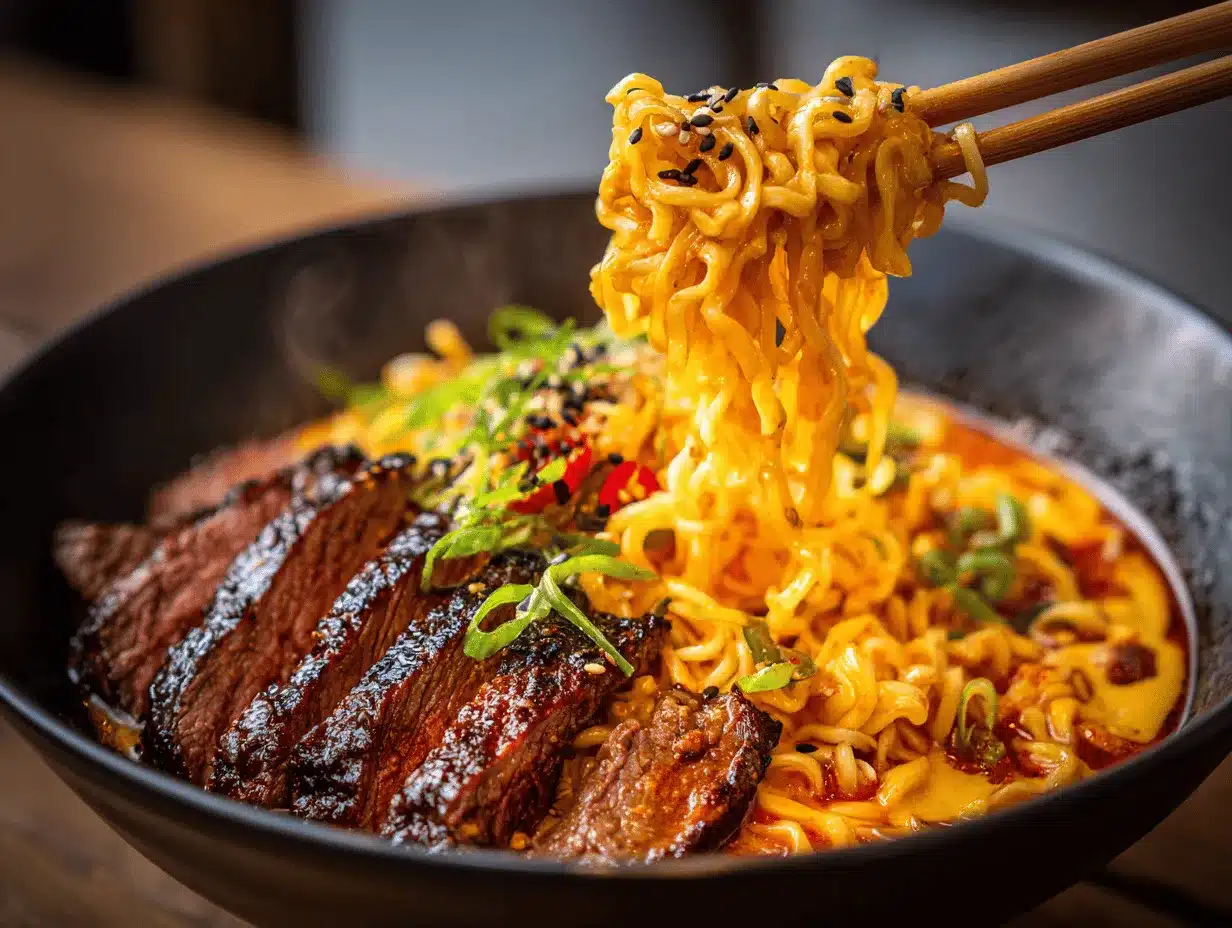
-
Marinate the Beef (10 minutes active, 20 minutes resting):
In a mixing bowl, combine 2 tbsp soy sauce, 1 tbsp gochujang, 1 tbsp brown sugar, 1 tsp sesame oil, minced garlic, and black pepper. Add the thinly sliced beef and toss until evenly coated. Let the beef marinate for at least 20 minutes at room temperature (or up to 2 hours in the fridge for deeper flavor). If you’re short on time, even 10 minutes helps.
Tip: The thinner you slice the beef, the faster it absorbs flavor and cooks.
-
Prep the Creamy Sauce (5 minutes):
While the beef marinates, whisk together softened cream cheese, milk, mayonnaise, garlic powder, salt, and pepper in a small bowl. It should be smooth and pourable—add a splash more milk if needed.
Note: If your cream cheese is cold, microwave it for 10 seconds to soften up. Lumps are the enemy—whisk until totally smooth.
-
Cook the Noodles & Veggies (10 minutes):
Bring a large pot of water to a boil. Add ramen noodles and cook according to package instructions (usually 3-4 minutes). About 1 minute before the noodles are done, toss in the carrots and mushrooms. Drain and set aside, keeping everything slightly undercooked—they’ll finish in the hot broth later.
Warning: Don’t overcook the noodles—they’ll turn mushy fast!
-
Simmer the Broth (5 minutes):
In the same pot, add the chicken or beef broth, 1 tbsp gochujang, 2 tsp soy sauce, sriracha or chili flakes (if using), and 1 tsp sesame oil. Bring to a gentle simmer. Taste and adjust heat or salt if needed—remember, everyone’s spice tolerance is different!
Sensory cue: The broth should smell spicy and savory, with a little smokiness from the gochujang.
-
Grill the Beef (5-7 minutes):
Heat a grill pan or cast-iron skillet over medium-high heat. Add the marinated beef in a single layer (work in batches if needed). Grill for 1-2 minutes per side, until deeply browned and slightly charred. Set aside.
Efficiency tip: Use tongs to flip quickly—thin slices cook fast!
-
Assemble the Bowls (3 minutes):
Divide the noodles, carrots, and mushrooms into two large bowls. Pour the simmering broth over each, then add the spinach or bok choy (the hot broth will wilt it perfectly). Arrange grilled beef on top.
Personal note: I like to fan the beef slices out for a pretty presentation, but honestly, it all ends up mixed together anyway!
-
Finish with Creamy Sauce & Toppings (2 minutes):
Drizzle the creamy sauce generously over the beef and noodles. Garnish with a soft-boiled egg, sesame seeds, green onions, kimchi, and chili peppers if you like. Serve immediately and get ready to slurp!
Troubleshooting: If your sauce is too thick, add more milk. If the broth is too spicy, swirl in a spoonful of the creamy sauce—it cools things down instantly. And if you overcook the noodles, don’t worry—just call it “extra hearty” and enjoy anyway.
Cooking Tips & Techniques
- Marinate for Flavor, Not Forever: Even 10-20 minutes makes a difference for the beef. If you forget to marinate ahead, toss the beef in the marinade while you prep everything else—just don’t skip this step.
- Grill Over High Heat: A screaming hot pan gives the beef those lovely charred edges. Don’t overcrowd—work in batches to keep the beef sizzling instead of steaming.
- Don’t Overcook Noodles: Ramen gets mushy fast. Undercook by 30 seconds so they finish perfectly in the hot broth.
- Balance the Broth: Taste as you go! Too spicy? Add a splash of broth or more creamy sauce. Not enough umami? A dash of soy sauce or fish sauce works wonders.
- Multitask Like a Pro: While the beef marinates, prep the veggies and creamy sauce. Use the noodle cooking water for blanching carrots and mushrooms—it saves dishes and time.
- Lessons Learned: Once, I forgot to soften the cream cheese and ended up with a lumpy sauce—trust me, room temp is key. Also, don’t skip drying the beef slices with a paper towel before marinating; it helps the marinade stick and gives you better browning.
- Consistency Counts: Slice the beef and veggies as evenly as possible for even cooking. And always serve ramen right away—the longer it sits, the more the noodles soak up the broth (not always a bad thing, but less slurpy!).
Variations & Adaptations
- Vegetarian: Swap the beef for pressed tofu or tempeh, marinate and grill the same way. Use vegetable broth and skip the egg if you want it vegan. I’ve made this with crispy tofu, and the creamy sauce makes it just as satisfying.
- Low-Carb/Keto: Use shirataki noodles or spiralized zucchini instead of ramen. The creamy sauce and grilled beef bring plenty of richness even without the carbs.
- Extra Veggies: Add bell peppers, snow peas, or shredded cabbage. In summer, I love tossing in fresh corn kernels or snap peas for a sweet crunch.
- Different Proteins: Try sliced chicken breast, pork tenderloin, or even shrimp. Adjust marinade time (shrimp only needs about 5 minutes).
- Allergen Swaps: For gluten-free, use tamari in place of soy sauce and gluten-free noodles. For dairy-free, use vegan cream cheese and plant-based milk in the sauce.
- Personal Twist: I once added a spoonful of peanut butter to the creamy sauce—wow, talk about nutty richness. If you like Thai flavors, give it a try!
Feel free to play around—the base recipe is super forgiving. Just keep the balance of spicy, creamy, and savory, and you’ll end up with a winner every time.
Serving & Storage Suggestions
This spicy Korean ramen with grilled beef is best served piping hot, straight from the stove. I love using big, deep bowls to show off all those gorgeous toppings—don’t forget an extra drizzle of creamy sauce and a sprinkle of sesame seeds for that Instagram-worthy finish.
Pair your ramen with a simple side of pickled cucumbers or a little extra kimchi for crunch. A cold Korean beer or sparkling water with lime is perfect alongside, especially if you’ve gone heavy on the spice.
Got leftovers? Store the broth, noodles, and toppings separately in airtight containers in the fridge for up to 3 days. Noodles soak up liquid as they sit, so it’s best to keep them apart if you can. To reheat, warm the broth gently on the stove or in the microwave, then add the noodles and beef just until heated through. The creamy sauce can be microwaved in short bursts and whisked smooth again if it thickens up.
Honestly, the flavors get even deeper after a day in the fridge—just don’t let the noodles get too soggy. If you freeze anything, stick to the beef and broth (noodles tend to turn to mush after thawing).
Nutritional Information & Benefits
This spicy Korean ramen recipe with grilled beef and creamy sauce is a balanced meal, packing about 600-700 calories per serving, 30-35 grams of protein, and plenty of satisfying carbs and healthy fats. The beef brings muscle-building protein and iron, while the veggies add fiber and vitamins. Gochujang is rich in probiotics and antioxidants, and that creamy sauce (with cream cheese and milk) offers a dose of calcium and extra richness.
If you’re watching your carbs, try the low-carb noodle swaps. For dairy-free, use vegan substitutes for the sauce. Main allergens include wheat (noodles), soy (soy sauce, gochujang), and dairy (cream cheese/milk), so be sure to adjust as needed.
I love serving this as a hearty dinner after a workout—it’s filling, flavorful, and the heat really wakes you up! As always, adjust the spice and richness to your needs, and enjoy every slurp knowing you made something delicious and nourishing.
Conclusion
There’s just nothing like a steaming bowl of spicy Korean ramen with grilled beef and creamy sauce on a cozy night—in my kitchen, it’s become a little ritual of comfort and flavor. Every bite bursts with smoky beef, spicy broth, and that ridiculously good creamy drizzle. It’s easy enough for a busy weeknight but special enough to impress anyone who grabs a seat at your table.
Don’t be afraid to tweak the toppings, play with the spice, or try a different protein—the beauty of ramen is making it your own. For me, it’s the perfect blend of heat, heartiness, and just a touch of indulgence that keeps me coming back for more.
If you give this recipe a try, I’d love to hear how it turns out! Drop a comment below, share your bowl on Pinterest, or tell me your favorite ramen twist. Happy slurping, friends—may your ramen always be spicy, creamy, and totally irresistible!
Frequently Asked Questions (FAQs)
Can I make this spicy Korean ramen less spicy?
Absolutely! Just use half the gochujang and skip the sriracha or chili flakes. The creamy sauce also helps mellow out the heat, so add a little extra if you’re sensitive to spice.
What’s the best cut of beef for ramen?
I find sirloin or ribeye works best because they’re tender and cook quickly. If you want a more budget-friendly option, flank steak (thinly sliced against the grain) is great too.
Can I prepare the components ahead of time?
Yes! Marinate and grill the beef up to a day in advance, and mix up the creamy sauce ahead of time. Just cook the noodles fresh before serving for the best texture.
Is there a vegetarian version of this recipe?
Definitely. Use tofu or tempeh instead of beef and vegetable broth for the base. The creamy sauce and spicy broth work just as well with plant-based proteins.
How do I keep the noodles from getting soggy?
Keep the noodles, broth, and toppings separate if you’re storing leftovers. Combine them only when ready to eat, and reheat gently to avoid mushy noodles.
Pin This Recipe!

Spicy Korean Ramen with Grilled Beef and Creamy Sauce
This spicy Korean ramen features chewy noodles, marinated grilled beef, and a luscious creamy sauce for the perfect balance of heat and richness. It’s a comforting, flavor-packed homemade bowl that’s easy enough for weeknights but impressive enough for guests.
- Prep Time: 20 minutes
- Cook Time: 20 minutes
- Total Time: 40 minutes
- Yield: 2 servings 1x
- Category: Main Course
- Cuisine: Korean
Ingredients
- 8 oz beef sirloin or ribeye, thinly sliced
- 2 tbsp soy sauce (low-sodium is fine)
- 1 tbsp gochujang (Korean chili paste)
- 1 tbsp brown sugar
- 1 tsp sesame oil
- 1 clove garlic, minced
- 1/2 tsp ground black pepper
- 2 packs ramen noodles (about 6 oz total, fresh or instant, discard flavor packets)
- 4 cups chicken or beef broth (low-sodium preferred)
- 1 tbsp gochujang
- 2 tsp soy sauce
- 1 tsp sriracha or Korean chili flakes (optional)
- 1 tsp sesame oil
- 1/2 cup mushrooms, sliced (shiitake, cremini, or white)
- 1/2 cup carrots, julienned or thinly sliced
- 1/2 cup baby spinach or bok choy
- 2 green onions, thinly sliced
- 2 oz cream cheese, softened
- 1/4 cup whole milk (or oat milk for dairy-free)
- 1 tbsp mayonnaise (preferably Kewpie)
- 1/2 tsp garlic powder
- Pinch of salt and black pepper
- 1 soft-boiled egg, halved (optional)
- Sesame seeds (white or black, optional)
- Chopped cilantro or parsley (optional)
- Kimchi (optional)
- Thinly sliced chili peppers (optional)
Instructions
- In a mixing bowl, combine 2 tbsp soy sauce, 1 tbsp gochujang, 1 tbsp brown sugar, 1 tsp sesame oil, minced garlic, and black pepper. Add thinly sliced beef and toss to coat. Marinate for at least 20 minutes at room temperature or up to 2 hours in the fridge.
- While beef marinates, whisk together cream cheese, milk, mayonnaise, garlic powder, salt, and pepper in a small bowl until smooth and pourable. Add a splash more milk if needed.
- Bring a large pot of water to a boil. Add ramen noodles and cook according to package instructions (3-4 minutes). About 1 minute before noodles are done, add carrots and mushrooms. Drain and set aside, keeping everything slightly undercooked.
- In the same pot, add broth, 1 tbsp gochujang, 2 tsp soy sauce, sriracha or chili flakes (if using), and 1 tsp sesame oil. Bring to a gentle simmer. Taste and adjust seasoning as needed.
- Heat a grill pan or cast-iron skillet over medium-high heat. Add marinated beef in a single layer and grill for 1-2 minutes per side until browned and slightly charred. Set aside.
- Divide noodles, carrots, and mushrooms into two large bowls. Pour simmering broth over each, then add spinach or bok choy (the hot broth will wilt it). Arrange grilled beef on top.
- Drizzle creamy sauce generously over beef and noodles. Garnish with soft-boiled egg, sesame seeds, green onions, kimchi, and chili peppers if desired. Serve immediately.
Notes
Marinate beef for at least 10-20 minutes for best flavor. Slice beef and veggies evenly for even cooking. Undercook noodles slightly to avoid mushiness. Adjust spice level by reducing gochujang or omitting sriracha/chili flakes. For gluten-free, use tamari and rice noodles. For dairy-free, use vegan cream cheese and plant milk. Store broth, noodles, and toppings separately for leftovers.
Nutrition
- Serving Size: 1 large bowl (half of recipe)
- Calories: 650
- Sugar: 10
- Sodium: 1800
- Fat: 28
- Saturated Fat: 10
- Carbohydrates: 68
- Fiber: 4
- Protein: 33
Keywords: spicy ramen, Korean ramen, grilled beef ramen, creamy ramen, homemade ramen, gochujang noodles, comfort food, easy ramen, weeknight dinner, Asian noodles
